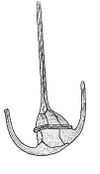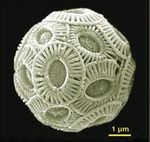Effects of climate change on the Mediterranean
This article reports findings of the MARBEF subprojects MARPLAN and DEEPSETS in the period 2005-2008.
Contents
The Mediterranean ecosystem
The Mediterranean Sea has a relatively high species diversity, largely due to its long evolutionary history and the prehistoric introduction of many Atlantic species into the Mediterranean. The present-day high species richness is due to spatial coexistence of warm water species (thriving in the summer) and cold-water species (thriving in the winter). This seasonal change in species activity is a buffer against the effects of environmental variation, because a varied set of species is more likely to adjust to environmental change [1].
Previous changes
Since the 1980s, the Mediterranean marine biota have experienced rapid, dramatic changes, illustrated by alteration of food webs, mass mortalities, and population explosions such as jellyfish outbreaks. These changes are caused by intense anthropogenic activities, but also by climate change.
The advance of warm-water species represented the first evidence of a linkage between climate change and distribution patterns in the Mediterranean Sea. This phenomenon is particularly evident in fish, where over 30 native (warm-water) species have already spread into northern areas. Almost all of the 100 fish species newly recorded in the Mediterranean are of warm-water affinity. At the same time, the physical properties of the basin have changed and temperatures have increased.[1] .

Global change and microplankton
Microplankton diversity
Plankton organisms can range in size from a few metres for large jellyfish and salp colonies to less than a micrometre for bacteria. Within the MarPLAN project the biodiversity of eukaryotic marine single-celled plankton organisms was studied in order to answer the question “In what ways can global change affect microplankton in the Mediterranean?”
To understand plankton distribution and changes therein, we first need to know how diverse it is. Diversity can be hidden within an easily identifiable morphologically defined species. Although this species may be considered cosmopolitan, it can possibly consist of several separate species, or populations, each with a different distribution patter.
For example, MarPLAN discovered that the cosmopolitan species Fibrocapsa japonica in fact consists of two different species. The second one was discovered in the Adriatic Sea[1].
Global change and phytoplankton
In the temperate zones, many phytoplankton species form blooms during restricted periods of the year. Global warming caused some species to bloom earlier in certain places, and to shift the distribution of these blooms towards the poles. New species may appear in regions, partly through introduction (for example, via ballast water dumping) and partly through polewards range expansion of warm-water species.
Several MarPLAN researchers collaborated to assess these trends in the dinoflagellate genus Ceratium.
Over the last century, several Ceratium species have disappeared from study sites in Villefranche sur Mer and Naples, or have become far less common, while new dinoflagellate species have recently appeared.
Another driver of global change is the increased concentration of CO2 in the atmosphere, which results in a higher CO2 concentration in the upper layers of the ocean. This might seem a good thing for phytoplankton. However, there is a less favourable side-effect: with increasing CO2 in the seawater, the acidity increases (the pH drops). As the acidity of seawater increases, it will be more difficult to produce the mineral calcium carbonate. This can cause problems for phytoplankton species that utilise calcium carbonate as a construction material for their cell walls. The coccolithophorid Emiliania huxleyi is one such species: it forms discs of calcium carbonate called coccoliths, which appear to provide protection to the cell[1].
Harmful phytoplankton blooms
Many phytoplankton species produce toxins or otherwise constitute a nuisance to other species, including humans (see also: here and here). Such species (for example, Fibrocapsa japonica) are harmful and, when they appear in large numbers, form harmful algal blooms (HABs). Global change may cause increasing numbers of HABs to appear in coastal regions.[1].
Global change and zooplankton
The appearance of zooplankton (copepods, planktonic larvae of meiobenthos) may be triggered by different factors: increased temperatures may affect the timing of appearance of certain species differently. If grazers such as planktonic larvae are out of phase with their food source they will starve and not make it into adulthood. Populations of benthic species which rely on zooplankton for nutrients may also decrease. These temporal changes, documented by the DEEPSETS project, have occurred within our lifetime.[1].
Global change and the deep Mediterranean
DEEPSETS research has shown that the eastern Mediterranean is subjected to periodical events which deliver large amounts of food to the sea floor. These events abruptly turn the ‘desert’ into an ‘oasis’. This was illustrated by the very high phyto-pigment concentrations in the Ierapetra Basin during 1993. These were linked to an increased flow of nutrient-rich water into the Cretan Sea after 1992, which resulted in an enhanced biological productivity and organic matter flux to the seabed. In 1993, this enhanced flux caused significant changes in the abundance and composition of the meiobenthic assemblages as well as of the planktonic and macrobenthic communities.[1]
Global change and fishes
Reliable tools have been developed to detect declining species, isolated populations and exotic species. Climate change is thought to cause range shifts of marine fish species and local and global extinctions are predicted, although the latter is yet to be observed.
Small pelagic fish species, in particular, have large population sizes and a high potential for gene flow. Therefore, they may respond rapidly to changes in physical oceanographic conditions. They have, for instance, shown large population fluctuations and local extinctions over glacial time-scales.[1]
Global change and sprat
MarBEF presented a range-wide phylogeographic survey of European sprat (Sprattus sprattus), based on a 530-base-pair sequence from mitochondrial DNA. This DNA region demonstrated the existence of genetically isolated populations in northern Mediterranean basins. MarBEF concluded that these populations, which have a significantly reduced genetic diversity, remain isolated because they can't maintain gene flow with other populations under the present physical oceanographic regime.
This result demonstrates the effects of past glacially-induced changes in physical oceanographic conditions on a cold-adapted small pelagic fish species. This species is now geographically isolated at its southernmost distribution limit, namely the northern Mediterranean.[1]
Global change and river outflow
Climate models predict increasing variance in rainfall, with increased frequency of droughts paralleled by unusual amounts of rainfall and floods. In anticipation of this, the Mediterranean region is now being subjected to extensive river damming, which can have far reaching impacts on coastal food webs. For instance, the diets of the five most abundant flat fish species of the Gulf of Lions and their prey depend on river inputs. The common sole largely profits from the contributions from terrestrial organic matter, via their main prey: deposit-feeding polychaete worms. Therefore inland climate changes may affect coastal marine food webs, through variation in river flow.[1]
Predictions
Endemic native species with cold-water affinity, common in the northern part of the Mediterranean, will probably decline and eventually be lost. A decline in their occurrence has been reported already. It is also possible that some of these species might become adapted to the new conditions, after periods of stress.
The seaweed Fucus virsoides, an endemic flagship species of the Northern Adriatic (the coldest portion of the Mediterranean Sea), appeared to suffer severe stress in former years, whereas it is now particularly abundant, for example in Venice. In general, the recent warming has facilitated the establishment and distribution of tropical, exotic species that have been introduced either via the Suez Canal or by maritime transport. This process is fast advancing, and more than 500 non-indigenous species have already been recorded in the Mediterranean. Some undoubtedly raise some concern, such as the jellyfish Rhopilema nomadica – which even shut down a nuclear power plant by clogging its cooling system – whereas others are becoming a resource for fisheries. Entire replicas of tropical communities from the Red Sea have already been recorded from a few Mediterranean locations.
From this it can be concluded that if the Mediterranean continues to warm at the same rate, all its sub-regional, biological peculiarities may rapidly disappear, to be replaced by a more homogeneous, tropical-like ecosystem [1] .
References
- ↑ 1.00 1.01 1.02 1.03 1.04 1.05 1.06 1.07 1.08 1.09 1.10 Heip, C., Hummel, H., van Avesaath, P., Appeltans, W., Arvanitidis, C., Aspden, R., Austen, M., Boero, F., Bouma, TJ., Boxshall, G., Buchholz, F., Crowe, T., Delaney, A., Deprez, T., Emblow, C., Feral, JP., Gasol, JM., Gooday, A., Harder, J., Ianora, A., Kraberg, A., Mackenzie, B., Ojaveer, H., Paterson, D., Rumohr, H., Schiedek, D., Sokolowski, A., Somerfield, P., Sousa Pinto, I., Vincx, M., Węsławski, JM., Nash, R. (2009). Marine Biodiversity and Ecosystem Functioning. Printbase, Dublin, Ireland ISSN 2009-2539 Cite error: Invalid
<ref>tag; name "ma" defined multiple times with different content Cite error: Invalid<ref>tag; name "ma" defined multiple times with different content Cite error: Invalid<ref>tag; name "ma" defined multiple times with different content Cite error: Invalid<ref>tag; name "ma" defined multiple times with different content

